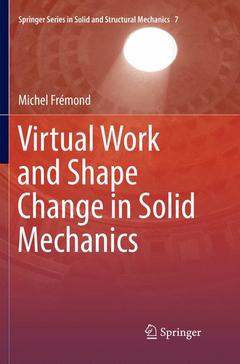Virtual Work and Shape Change in Solid Mechanics, 1st ed. 2017 Springer Series in Solid and Structural Mechanics Series, Vol. 7
Auteur : Frémond Michel

Introduction.- The System.- The Principle of Virtual Work.- What We See: the Velocities.- The Actions which are Applied to the System: the Work of the External Forces.- What We See: the Velocities of Deformation.- The Work to Change the Shape of the System.- The Work to Change the Velocities of the System.- The Principle of Virtual Work and the Equations of Motion.- Summary of the Abstract Setting to get the Equations of Motion.- Two Points on a Line.- Three Disks in a Plane.- Three Balls on a Plane.- A Deformable Solid.- Two Deformable Solids.- At a Distance Interactions: Continuum Reinforced by Fibers.- At a Distance Interactions: Continuum Reinforced by Beams.- At a Distance Interactions: Continuum Reinforced by Plates.- Damage of a Connection.- Damage of a Rod Glued on a Rigid Surface.- Damage of a Beam Glued on a Rigid Surface.- A Damageable Solid.- Two Damageable Solids.- Porous Solids.- Discontinuum Mechanics: Collisions and Fractures in Solids.- There is neither Flattening nor Self-contact or Contact with an Obstacle. Smooth Evolution.- There is neither Flattening nor Self-contact or Contact with an Obstacle. Non Smooth Evolution.- There is no Flattening. There is Self-contact and Contact with an Obstacle. Smooth Evolution.- There is no Flattening. There is Self-contact and Contact with an Obstacle. Non Smooth Evolution. Flattening. Smooth and Non Smooth Evolutions.- Conclusions.
Explains how the principle of virtual work represents a tool for analysis of the mechanical effects of the evolution of the shape of a system
Applies the principle of work to predict the motion of solids with large deformations
Includes examples of both usual and unusual shape changes
Derives equations for smooth and nonsmooth motions
Includes supplementary material: sn.pub/extras
Date de parution : 06-2018
Ouvrage de 371 p.
15.5x23.5 cm
Date de parution : 10-2016
Ouvrage de 371 p.
15.5x23.5 cm
Mots-clés :
Deformable Solids; Discontinuum Mechanics; Large Deformations; Damageable Solids; Porous Solids; Rod Glued; Beam Glued; Deformable Solids; Equations of Motion; Lagrangian Mechanics; Solid Mechanics; Surface Damage; Collision Engineering; Solid Mechanics; Continuum Mechanics; Structural Mechanics



